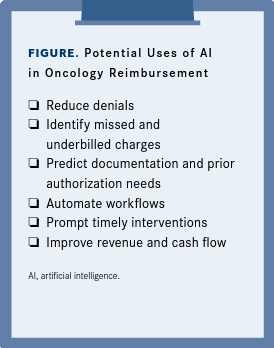The Future of Reimbursement: How AI Can Revolutionize Oncology Practices
By retrospectively analyzing health care financial data and using the intelligence generated to guide future claims to a more successful outcome, machine learning platforms may reduce the need for repeated insurance submissions and appeals and can improve the practice’s clean claim rate.
Dan Lodder, MBA

Artificial intelligence (AI) and machine learning platforms offer physicians the opportunity to optimize efficiency in revenue cycle management. By retrospectively analyzing large amounts of health care financial data and using the intelligence generated to guide future claims to a more successful outcome, machine learning platforms have the potential to reduce the need for repeated insurance submissions and appeals and can significantly improve the practice’s clean claim rate. In addition, improving revenue cycle results can help reduce the potential financial burden on patients.
Health care in the US is a complex industry that spends hundreds of billions of dollars a year on nonclinical administrative expenses. A February 2019 report from McKinsey & Company attributed high administrative expenses to 2 factors1:
- The number of providers and payers who interact to process administrative information
- Time-consuming reporting requirements
Billing and insurance-related overhead make up the largest share of these administrative costs. This is because of the complexity of the billing and payment process, which is far more intricate and less standardized than in any other industry.1 Navigating the complex requirements and preapprovals needed for coverage of cancer treatments can be logistical and administrative challenge. Additionally, assessing whether a claim will be paid or denied is difficult for even the most sophisticated practices. The result is a lengthy process of submitting claims, researching denials, and managing appeals. Moreover, as 60% of rejected reimbursement claims are never resubmitted because of the high cost of reworks and appeals.2
Administrative Burden
All of these challenges result in an increased administrative burden, leading to substantial costs that can detract from patient care.3 In 2019, health care costs totaled 16.8% of the US gross domestic product (GDP), and administrative costs consistently make up as much as 15% to 30% (over $150 billion) of this annual total.3,4 Traditional claims scrubbing solutions can assist in preventing some insurance denials, but as much as 20% of claims are still denied, rejected, or underpaid.2 Simple adjustments in this process could save billions of dollars in overhead for health care providers. AI and machine learning technologies can be a solution.
Advancing Reimbursement Using AI
AI and machine learning technologies can solve potential denials before a claim is ever submitted. McKesson’s vision is to create a novel machine learning platform that serves as a financial intelligence infrastructure to reduce administrative friction and improve total performance across the health care revenue cycle. Its machine learning model integrates years of historical claims data spanning all major treatments, provider specialties, major payers, and plan types to predict claim denials and guide submissions, with the goal of increasing reimbursement for oncology treatments and reducing the administrative burden that can detract from patient care. These machine learning platforms, including McKesson’s subsidiary Glide Health, help oncology health care providers reduce denials, identify missed and underbilled charges, predict documentation and prior authorization needs, and automate workflows with timely interventions (Figure). For example, Glide Health connects across operations and integrates with existing practice management and billing systems to provide targeted guidance for improving revenue and cash flow.
Figure. Potential Uses of AI in Oncology Reimbursement

Adding Value Back to Health Care
The US spends approximately $1055 per capita annually on the administrative costs associated with health care. Addressing this inefficiency in health care practices is essential to decreasing medical costs and ensuring patients with cancer have access to the treatments they need. With the help of AI and machine learning technologies, we can reduce the burden of navigating complex insurance coverage and reimbursement processes, allowing providers to spend more time focused on their patients.
References
- Sahni N, Kumar P, Levine E, Singhal S. The productivity imperative for healthcare delivery in the United States. McKinsey & Company. February 27, 2019. Accessed April 5, 2023. bit.ly/3U9agqx
- Poland L, Harihara S. Claims denials: a step-by-step approach to resolution. Journal of AHIMA. April 25, 2022. Accessed April 5, 2023. bit.ly/411U3W5
- The role of administrative waste in excess US health spending. Health Affairs. Updated November 1, 2022. Accessed April 5, 2023. bit.ly/3KBAKhe
- Chernew M, Mintz H. Administrative expenses in the US health care system: why so high? JAMA. 2021;326(17):1679-1680. doi:10.1001/jama.2021.17318




